Once substance H is developed, the addition of the sugar N-acetylgalactosamine to the terminal position of the chain gives the molecule "A" antigenic activity.
Which specific terminal sugar causes a red cell to have A antigenic activity?
Patient's with diseases such as congential hemolytic anemias and aplastic anemias require frequent transfusions. Each unit of red cells contains 225 mg of iron, which puts these patients at risk for iron overload.
Blood Bank
Patients with diseases that require chronic transfusions are at risk for iron overload.
In healthy individuals, procalcitonin is only synthesized by the thyroid C cells. In bacterial infections, PCT is synthesized in various extrathyroidal neuroendocrine tissues.
In healthy individuals, procalcitonin is synthesized by which cells in the body?
May-Hegglin anomaly is a rare autosomal dominant condition in which patients are at risk for bleeding and infections. It is characterized by the presence of large Dohle body like inclusions within neutrophils, eosinophils, basophils, and monocytes.
The WBC anomaly indicated by the arrow in this illustration is:
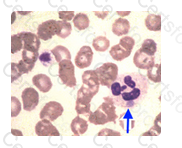
The recommended order of draw for a complete blood count (CBC), prothrombin time, and cholesterol is:
Either immunofixation or immunoelectrophoresis can be used to confirm Bence-Jones proteinuria.
Which of the following methods would be used to confirm the presence of Bence-Jones protein in the urine:
The cell depicted with the arrow in this image is an atypical (reactive) lymphocyte. These cells are common found in certain viral infections, especially infectious mononucleosis. Notice the larger size and abundant cytoplasm present in this lymphocyte. There is also apparent vacuoliation which is a key feature of atypical lymphocytes. The chromatin pattern of this cell as well as the overall shape, color and size rules out the monocyte, macrophage, and mesothelial cell choices.
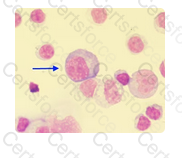
A patient with an infectious mononucleosis infection presents in the emergency room. Physicians order a spinal tap which is immediately sent to the laboratory for review. Please identify the cell in the image below from this patient's cerebrospinal fluid sample.
The activities conducted in a laboratory with a certificate of waiver include:
Neutrophils, lymphocytes and macrophage/ monocytes can be found in all types of body fluid differentials. Bronchial cells can be found only in bronchial washings and BAL specimens. Mesothelial cells are found only in serous body fluids including pleural fluid, peritoneal fluid, and pericardial fluid.
Select the specific cells listed below that can be found in all types of body fluid.
Antibodies in the Rh system typically exhibit which one of the following characteristics?
What is the cell that is indicated by the arrow in this field?
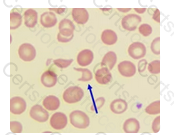
The cells indicated by the arrows in the image are spherocytes. Spherocytes have a decreased surface to volume ratio and are therefore smaller with an increased MCHC. Spherocytes have lost their bi-concave shape and are spherical in shape, hence the name.
What are the cells that are indicated by the arrows in this peripheral blood smear image?
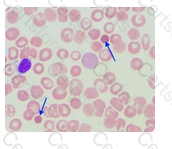
The correct designation for a generalist laboratory professional with a bachelor's degree certified by the American Society for Clinical Pathology is
Isolation and detection of Gardnerella vaginalis from vaginal secretions is improved by which of the following?
The identification of the crystals depicted in this image are triple phosphate crystals. Triple phosphate crystals may be normal but are usually associated with alkaline urine. These colorless crystals have a characteristic "coffin lid" appearance.
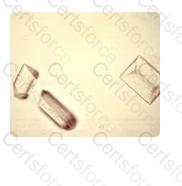
What is the identification of these crystals seen in urine with an alkaline pH?